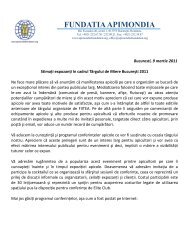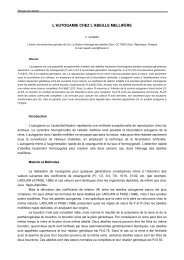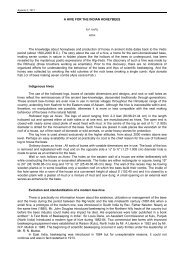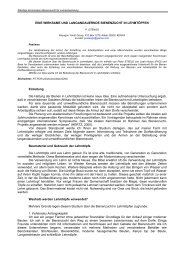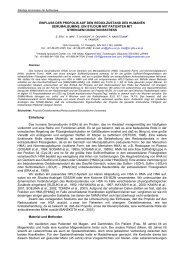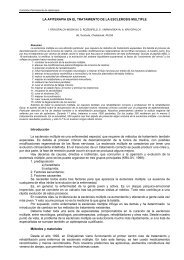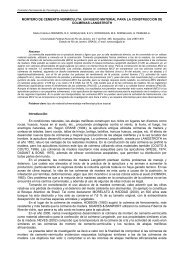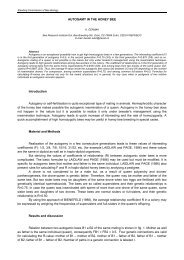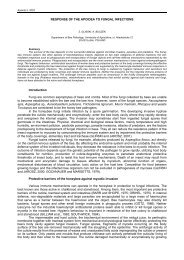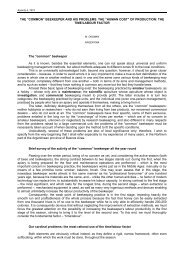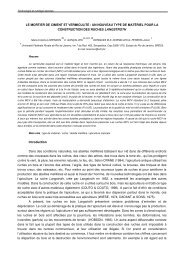performance of africanized workers bees, apis mellifera ... - Apimondia
performance of africanized workers bees, apis mellifera ... - Apimondia
performance of africanized workers bees, apis mellifera ... - Apimondia
Create successful ePaper yourself
Turn your PDF publications into a flip-book with our unique Google optimized e-Paper software.
Standing Commission for Beekeeping Technology and Equipment<br />
PERFORMANCE OF AFRICANIZED WORKERS BEES, APIS MELLIFERA HIVES AND PROPOLIS<br />
PRODUCTIVITY, TOTAL AND BY PARTS OF THE BOX, EVALUATED BY FOUR TECHNIQUES OF<br />
PRODUCTION IN THE FOUR SEASONS OF THE YEAR<br />
Lucimar PERES DE MOURA PONTARA 1 , Regina Helena NOGUEIRA COUTO 2 , V. BETT 1 , M.R. NANNI 1 , Selma Lucy FRANCO 1 ,<br />
F. DO LAGO RAMOS 1 , R. ALVAREZ 1<br />
1<br />
Universidade Estadual de Maringá, Av. Colombo, 5790, 87020-900, Maringá, BRAZIL, E-mail: pontara@wnet.com.br<br />
2<br />
Universidade Estadual Paulista, Câmpus de Jaboticabal, Via de Acesso Pr<strong>of</strong>. Paulo D. Castelane, s/n, 14884-90, Jaboticabal, BRAZIL<br />
Introduction<br />
The propolis has been investigated in Brasil mainly for its medical features. BREYER (1996) have<br />
suggested that brazilian propolis, mostly in the South, is considered one <strong>of</strong> the best all over the world due its<br />
excellent quality pattern.<br />
SAMPAIO (2000) considered the effective indexes in the economical market <strong>of</strong> propolis in 1999<br />
about 49 ton <strong>of</strong> production by year and invoicing <strong>of</strong> R$ 3.920.000,00/year, proving the development <strong>of</strong> the<br />
production level to 15% to the pharmaceutical industry, 10% to pharmacies and 75% to exportation.<br />
The quantity <strong>of</strong> propolis collected by <strong>bees</strong> has the average sited in the genetic origin, seasons <strong>of</strong> the<br />
year and area (GHISALBERTI, 1979; CRANE, 1990). There are some doubts about whose species have<br />
more production <strong>of</strong> propolis. Some authors attribute this ability to Apis <strong>mellifera</strong> caucasica <strong>bees</strong> (MOBUS,<br />
1972).<br />
The selection <strong>of</strong> <strong>bees</strong> for propolis production was made with success by MANRIQUE and SOARES<br />
(2000). They obtained selected hives representing major production and propolis presenting more contents<br />
<strong>of</strong> flavonoids.<br />
According to BANSKOTA et al. (1998), Baccharis sp. and Araucaria heter<strong>of</strong>ila probably are the<br />
major sources <strong>of</strong> brazilian propolis resins. The propolis presents a complex composition, with flavonoids,<br />
which give several activities concerning to the natural immune response and antibacterial activity (BANKOVA<br />
et al., 1995; SFORCIN, 1996; SCHELLER et al., 1999)<br />
The propolis productivity is not much studied. In some studies we can find an important mention <strong>of</strong><br />
the works <strong>of</strong> PROST-JEAN (1985), PIDEK (1987), IANNUZZI (1993), BREYER (1995), ADOMAR (1996),<br />
GARCIA et al. (1997), ALMEIDA et al. (2000), BRIGHENTI and GUIMARÃES (2000), MANRIQUE and<br />
SOARES (2000), MOURA et al. (2000), PONTARA et al. (2001).<br />
According to BREYER (2000), the continuous development <strong>of</strong> research on the investigation <strong>of</strong> the<br />
complex composition <strong>of</strong> propolis and its application day by day updated in products to human and animal<br />
purposes, associated with the marked demands in qualification, have made changes in the application and<br />
development <strong>of</strong> more specialized techniques in the production area.<br />
The goal <strong>of</strong> this work was to evaluate the production <strong>of</strong> propolis <strong>of</strong> <strong>africanized</strong> Appis <strong>mellifera</strong> <strong>bees</strong><br />
submitted to four techniques <strong>of</strong> collection inducting the propolis production in different periods <strong>of</strong> the year, in<br />
the parts <strong>of</strong> the hive and the total production in 500 days. It was evaluated the correlation <strong>of</strong> production on<br />
feed area, <strong>of</strong>fspring, extra and total, as well the conditions <strong>of</strong> internal and external maximal and minimal<br />
temperatures, relative air moisture maximal and minimal and precipitation.<br />
Material and Methods<br />
The experiment was conducted in the Apicultural Sector <strong>of</strong> the Zootechny Department <strong>of</strong> the State<br />
University <strong>of</strong> Maringá – PR, Brazil in Northeast region <strong>of</strong> Parana State in an altitude <strong>of</strong> 542 m and<br />
geographical coordinates <strong>of</strong> 23 o 25’ <strong>of</strong> latitude South and 51 o 57’ <strong>of</strong> longitude West from the period <strong>of</strong> January<br />
<strong>of</strong> 1998 to May 1999. The regional climate is tropical temperate, presenting rainy summers and dry winters.<br />
The average in the temperature <strong>of</strong> the region in the last 19 years was 22,9 ºC and pluvial precipitation<br />
averaged 1607,6 mm, according to information <strong>of</strong> the Centro de Meteorologia da UEM (Meteorological<br />
Centre at UEM). There were four adaptations to the Langstroth model to propolis production, producing a<br />
pattern in the techniques <strong>of</strong> collection <strong>of</strong> propolis such as: T1= glass (plaques <strong>of</strong> transparent glass close to<br />
the internal and lateral walls, near the little boxes 1 and 10); T2=Scraping (BREYER, 1995); T3= Intelligent<br />
Propolis Collector or CPI=the lateral parts were substituted by mobile slats according to ADOMAR (1996)<br />
and T4=Control, with one unique collection in the end <strong>of</strong> the experiment (BREYER, 1995). To study partial<br />
and totally periods, the propolis was collected by techniques T1, T2 and T3, in the last day <strong>of</strong> the periods I =<br />
12/01 to 23/04/98 (Summer/Fall), II = 24/04 to 27/08/98 (Fall/Winter), III =28/08/98 to 21/01/99<br />
(Winter/Spring/Summer) and IV=22/01 to 27/05/99 (Summer/Fall).<br />
In the beginning <strong>of</strong> each period, every box <strong>of</strong> the three techniques was substituted in the same day<br />
by free propolis boxes, took to the laboratory to propolis collection <strong>of</strong> the following parts and the little boxes
Standing Commission for Beekeeping Technology and Equipment<br />
were collected in field. The global production (500 days) <strong>of</strong> propolis was summed individually to the<br />
productions <strong>of</strong> the techniques T1, T2 and T3, in the periods I, II, III, IV and compared to the control<br />
technique, making the collection only in the last period (IV). To determinate the internal areas <strong>of</strong> the hives<br />
(food, <strong>of</strong>fspring, extra and total) in each period, a mapping was made using the modified method <strong>of</strong> FREIRE<br />
(1997) and adapting to the geographical information system (ASSUNÇÃO et al., 1990) together with the<br />
program named Sistema de Processamento de Informações Geocodificadas – SPRING (INPE, 1999),<br />
developed by the Instituto Nacional de Pesquisas Espaciais - INPE. This proceeding summed 2000 drawing<br />
honeycombs and the number <strong>of</strong> hexagons containing pollen found in other different areas were included in<br />
the counting and noticed, according COUTO (1991), where each 4 cm 2 square was considered as an<br />
average <strong>of</strong> 13 cells. The area obtained was reduced by the place where it was included and added to the<br />
pollen class. It was established a data bank whose concept <strong>of</strong> structure presented one category only<br />
(thematic) with thirteen classes. The internal maximal and minimal temperature <strong>of</strong> the boxes were collected<br />
weekly, and daily they observed the external climatic conditions according to the Meteorological Centre at<br />
FEI/UEM the experiment were developed in a randomised way using four techniques <strong>of</strong> propolis collection<br />
and five repetitions totalising 20 hives. The studies <strong>of</strong> partial and total production in the periods <strong>of</strong> I, II, III and<br />
IV were developed in a subdivided parcel strategy. The statistical analysis was made using the GLM<br />
proceeding (Sas, 1996), where mean were compared to Tukey Test (P
Standing Commission for Beekeeping Technology and Equipment<br />
Figure 1 - Means <strong>of</strong> propolis productivity in three techniques <strong>of</strong> collection (glass, scraping and CPI) in the periods I=01/12 to 04/23/98<br />
(Summer/Fall), II=04/24 to 08/27/98 (Fall/Winter), III=08/28/98 to 01/21/99 (Winter/Spring/Summer) and IV=01/22 to<br />
05/27/99(Summer/Fall)<br />
The best productivity <strong>of</strong> propolis in the region <strong>of</strong> Maringá – Pr (South <strong>of</strong> Brazil), was obtained in the<br />
hottest period <strong>of</strong> the year (19,71 o e 31,0 o C), agreeing with the studies <strong>of</strong> MANRIQUE and SOARES (2000) in<br />
the State <strong>of</strong> São Paulo and BREYER (2000) in the State <strong>of</strong> Paraná, who consider as the most productive<br />
period <strong>of</strong> propolis from January to April, although during the following months <strong>of</strong> May, June and July it was<br />
related a decrease <strong>of</strong> 66,64; 20,26 and 13,10%, respectively, <strong>of</strong> the similar behaviour to this experiment. The<br />
average production <strong>of</strong> propolis in the period II (80,4 g) was 65,54% inferior to the period I, 49,70% inferior to<br />
the period III and 51,94% inferior to the period IV (Figure 1).<br />
The analysis <strong>of</strong> variance <strong>of</strong> production in different parts <strong>of</strong> the hive, presented a significant difference<br />
to the techniques, in a level <strong>of</strong> 5% <strong>of</strong> probability to bottom and little box, and in a level <strong>of</strong> 1% to cover and<br />
wall. To the period it presented a significant difference (P
Standing Commission for Beekeeping Technology and Equipment<br />
Table IV<br />
Means propolis production (g) <strong>of</strong> the parts <strong>of</strong> wall, hole and cover referred to the <strong>africanized</strong> Apis <strong>mellifera</strong> hives<br />
submitted to three techniques <strong>of</strong> collection in the periods <strong>of</strong> I = Summer/Fall, II = Fall/Winter,<br />
III = Winter/Spring/Summer and IV = Summer/Fall<br />
Techniques<br />
Glass Scraping CPI<br />
Periods<br />
Means SD Means SD Means SD<br />
I 37,80bA 59,98 53,90bA 57,38 271,50aA 79,38<br />
II 0,00aA 0,00 0,00aA 0,00 93,60aB 31,47<br />
III 56,87aA 17,87 47,72aA 16,40 135,30aB 35,58<br />
IV 52,00abA 22,36 36,90bA 14,19 157,10aB 41,09<br />
I 14,90aB 12,22 21,40aA 14,49 25,20aA 21,57<br />
II 4,50aB 10,06 0,00aA 0,00 0,00aB 0,00<br />
III 8,52aB 9,08 9,54aA 6,62 6,05aAB 13,54<br />
IV 41,10aA 20,24 22,25abA 14,24 7,60bAB 10,43<br />
I 17,20bAB 6,88 27,50bA 10,47 63,10aA 9,55<br />
II 9,90aB 4,80 12,10aA 6,57 22,63aB 9,73<br />
III 26,30aA 9,57 21,45aA 7,56 19,07aB 5,64<br />
IV 24,40aAB 5,17 17,20aA 4,38 23,50aB 9,19<br />
Different letters, referred to the same part <strong>of</strong> the hive, case letters in the lines and capital letters in the columns, present difference by the Tukey Test (P
Standing Commission for Beekeeping Technology and Equipment<br />
were kept constant (homeotherm) in this period. In the period <strong>of</strong> fall/winter/98, when external maximal and<br />
minimal and averaged temperatures were the smaller, it was not the size <strong>of</strong> the swarm the factor which<br />
influenced propolis production but the applied technique. Studying the correlation (Table VI) between<br />
propolis production and the controlled variables, it was observed a positive and significant coefficient <strong>of</strong><br />
correlation <strong>of</strong> Pearson (P
Standing Commission for Beekeeping Technology and Equipment<br />
Figure 2 - Total propolis production means <strong>of</strong> <strong>africanized</strong> Apis <strong>mellifera</strong> hives submitted to four techniques <strong>of</strong> collection in the period<br />
from 12/01/1998 to 27/05/1999<br />
Conclusion<br />
The results found in this experiment showed superiority in technique CPI, related on the other<br />
treatments.<br />
The propolis production is more affected by the conditions <strong>of</strong> the environment than by the grade <strong>of</strong><br />
development <strong>of</strong> the colony and the biggest productivity in experimental conditions occurred during the hottest<br />
periods and smaller productivity during the colder periods.<br />
During the colder periods, the CPI produced more propolis than the other treatments, in comparison<br />
to <strong>of</strong>fspring and food areas and it was superior concerning production.<br />
The technique <strong>of</strong> propolis collection and the period <strong>of</strong> the year interfered in the propolis deposition in<br />
different parts <strong>of</strong> the box such as the alvado, bottom, cover, wall and little box.<br />
R E F E R E N C E S<br />
ADOMAR, J., Informações pessoais. Cooperado da CONAP (Cooperativa Nacional de Apitoxina), Belo Horizonte: Minas Gerais, 1996<br />
ALMEIDA, R., MANRIQUE, A. J., SOARES, A. E. E. Seleção de Melhoramento, Genético para Aumentar a Produção de Mel e Própolis.<br />
In: XIII CONGRESSO BRASILEIRO DE APICULTURA, 11, 2000, Florianópolis. Anais... Florianópolis, 2000<br />
ASSUNÇÃO, G. V., FORMAGGIO, A. R., ALVES, A. R., Mapa de aptidão agrícola das terras e uso adequado das terras: uma<br />
abordagem usando SGI e imagens de satélite. In: SIMPÓSIO BRASILEIRO DE SENSORIAMENTO REMOTO, 6, 1990, Manaus.<br />
Anais... São José do Campos : INPE, 1990. p.162 - 166<br />
BANKOVA, V., CRISTOV, R., KUJUMGIEV, A., MARCUCCI-MC., POPOV, S. 1995 Chemical composition and antibacterial activity <strong>of</strong><br />
Brazilian própolis. Zeitschrift-fur-Naturforschung.-Section-C,-Biosciences 50(3-4),167-172<br />
BANSKOTA, A.H., TEZUKA, Y., PRASAIN, J.K. et al. 1998., Chemical constituents <strong>of</strong> Brazilian propolis and their cytotoxic activities.<br />
J.Nat. Prod., 61, 896-900<br />
BREYER, H., Própolis produção com Apis <strong>mellifera</strong> L. In: XI CONGRESSO BRASILEIRO DE APICULTURA, 5, 1996, Teresina. Anais...<br />
Teresina, 1996<br />
BREYER, H.F.E., Aspectos de produção, coleta, limpeza, classificação e acondicionamento de própolis bruta de abelhas Apis <strong>mellifera</strong><br />
L. In: X SIMPÓSIO ESTADUAL DE APICULTURA DO PARANÁ E VII EXPOSIÇÃO DE EQUIPAMENTOS E MATERIAIS<br />
APÍCOLAS, 1995, Prudentópolis. Anais... Prudentópolis, Pr, 1995. p. 143<br />
BREYER, H.F.E., Técnicas de produção de própolis. In: XIII CONGRESSO BRASILEIRO DE APICULTURA, 11, 2000, Florianópolis.<br />
Anais... Florianópolis, SC, 2000<br />
BRIGHENTI, D.M., GUIMARÃES, C.R., Desenvolvimento de coletor da própolis de alta qualidade. In: XIII CONGRESSO BRASILEIRO<br />
DE APICULTURA, 11, 2000, Florianópolis. Anais... Florianópolis, SC, 2000<br />
COUTO, R.H.N. 1991., Produção de alimento e cria de hive de Apis <strong>mellifera</strong> infestadas de Varroa Jacobsoni, em regiões canavieiras.<br />
Jaboticabal, SP: UNESP, 1991. 131 p. Tese (Livre Docência em Apicultura) - FCAV – UNESP, 1991<br />
CRANE, E., 1990. Bees and beekeeping, science, practice and world resources. New York: Cornell Univ. P., 614<br />
FREIRE, A. G., Variação espaço-temporal e ecomorfologia de oito espécies da icti<strong>of</strong>auna dominante do Alto Rio Paraná. Maringá, Pr:<br />
UEM, 1997. 32 p. Tese (Doutorado em Ecologia de Ambientes Aquáticos) - Universidade Estadual de Maringá, 1997<br />
GARCIA, J., MOMMENSOHN, L.G., MOURA, L.P.P. et al., Produção de própolis em colônias de Apis <strong>mellifera</strong> africanizadas pela<br />
técnica convencional de scraping e coletor de própolis inteligente. In: 5ª REUNIÃO ESPECIAL DA SBPC, 11, 1997. Anais... UEM –<br />
Universidade Estadual de Maringá, 1997<br />
GHISALBERTI, E.L. (1979), Propolis: a review. Bee World., 60:59-84<br />
IANNUZZI, J. (1993), Propolis Collectors. American Bee J., 133:104-107<br />
INPE – INSTITUTO NACIONAL DE PESQUISAS ESPACIAIS. 1999. Apostila de Curso Spring 3.3: Spring Básico. INPE: 82p.
Standing Commission for Beekeeping Technology and Equipment<br />
MANRIQUE, A.J., SOARES, A.E.E., Variação Sazonal na produção de própolis no cerrado de Luiz Antônio, SP. In: XIII CONGRESSO<br />
BRASILEIRO DE APICULTURA, 11, 2000, Florianópolis. Anais... Florianópolis, SC, 2000<br />
MOBUS, B. 1972, The importance <strong>of</strong> propolis to the honey bee. Brit. Bee J., 19(8): 198-199<br />
MOURA, L.P.P., COUTO. R.H.N., ALVAREZ, R. et al., Produção de própolis em colônias de Apis <strong>mellifera</strong> africanizadas no verão por<br />
diferentes métodos. In: XIII CONGRESSO BRASILEIRO DE APICULTURA, 11, 2000, Florianópolis. Anais... Florianópolis, SC,<br />
2000<br />
PIDEK, A. 1987, The effectiveness <strong>of</strong> different methods <strong>of</strong> propolis production and utilization. Pszczelnicze-Zeszyty-Naukowe., 31: 55-<br />
73<br />
PROST-JEAN, P. (1985), Apicultura. Madrid: Ediciones Mundi-Prensa. 573p.<br />
SAMPAIO, I. M., Comércio Nacional de Produtos Apícolas. In: XIII CONGRESSO BRASILEIRO DE APICULTURA, 11, (2000),<br />
Florianópolis. Anais... Florianópolis, 2000<br />
SAS, INSTITUTE INC.. SAS User’s Guide: statistic. 6.ed., Cary: 1996, 956p.<br />
SCHELLER, S., DWORNICZAK, S., WALDEMAR-KLIMMEK, K. et al. (1999), Synergism between ethanolic extract <strong>of</strong> propolis (EEP)<br />
and anti-tuberculosis drugs on growth <strong>of</strong> mycobacteria. J. <strong>of</strong> Biosciences., 54:549-53<br />
SFORCIN, J.M., Efeito da sazonalidade sobre as propriedades imunomoduladora e antibacteriana da própolis e perfil bioquímico de<br />
ratos. Botucatu, SP.: UNESP, 1996. 59 p. Tese (Doutorado) – Universidade Estadual de São Paulo, 1996




